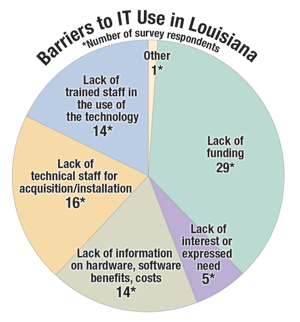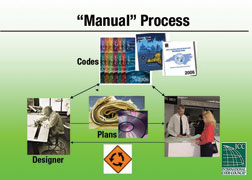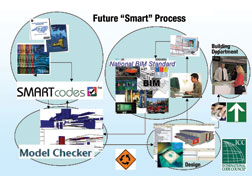...huge advances in service with plumbing and electrical but are only half way there right now. We hope to add electronic plan review in the future.”
 Alliance for Building Regulatory Reform Louisiana mirrors the U.S. in the ranking of impediments to IT use.
|
Milwaukee has had a digital tracking system for plan review in place since 2001 that also allows applicants to review status. The system is used to generate plan review letters and permit application forms. Permits issued are exported to the Dept. of Neighborhood Services’ permit and inspection system.
New York City’s e-filing program, first launched in February 2005 for those seeking to renew permits electronically, is such a hit that Buildings Commissioner Patricia Lancaster even got fan mail. One e-filer sent her a postcard from Hawaii to say thanks and let her know he had just renewed his permit from a computer in his beachfront hotel, says Kate Lindquist, press secretary for the Dept. of Buildings.
In 2006, New York City’s program was expanded to include e-filing for new electrical permit applications. Applicants can file, pay fees and immediately print a permit using the Internet. The city is currently developing digital filing capability for new buildings and alterations.
“With e-filing, the customer can conduct the transaction in less than five minutes,” says Lindquist. “You can obtain an electrical permit in your pajamas, if you so wish.”
Savings from online processing, derived from reduction in staff time and overhead associated with filing transactions, can be applied to more critical tasks, such as assisting with enforcement or more complicated permit applications, says Lindquist. A spillover benefit has been that registered licensees have more incentive to keep licenses and insurance up to date.
The biggest obstacle to e-filing is the fear of change. “It was a tough sell to many of the electricians,” says Lindquist.
Sarasota County, Fla., has no e-filing yet but hopes to within the next year. Two years ago, the county started using a computer system that allows inspectors with laptops in their cars to leave from home to do inspections. The interactive voice-response system calls contractors with the results of their inspections. If the contractor fails the inspection, the VRS gives the reason.
| + click to enlarge |
 |
 SMARTcodes will automate the current "manual" process, alowing designers to e-check and e-correct building information models for code compliance before they electronically submit plans to the reviewers, who, in turn, can also use SMARTcodes for plan review (below).
|
On the Way
Digital plan review is the most complex part of e-permitting still undeveloped. That could change over the next several years, thanks in part to the SMARTcodes development project of International Code Council, the Washington, D.C.-based code developer that publishes a series of codes, including the International Building Code. Work on SMARTcodes, an e-tool for designers and plan reviewers to automatically check for code compliance, began in 2005, in coordination with the buildingSMART initiative led by the International Alliance for Interoperability.
SMARTcodes, ICC’s first research and development project, involves putting ICC’s family of building codes, beginning with the energy conservation code, into a format that computer systems can understand and apply as limiting rules, says David R. Conover, senior adviser to ICC. “We’re doing groundbreaking work here,” he adds, declining to say how much money ICC is investing.
Conover projects that by early next year the "smart" International Energy Conservation Code will be available for beta testing on the Internet. Other Smartcodes will follow, all accessible over the Internet. Conover hesitates to be specific about a timetable because progress is dependent on software developers, who need to include code checking in their building modeling packages. “This is like a stereo system,” he says. “We have the music but we can’t play it until we receive the amplifier, turntable and speakers.”
| Difference in construction volume? | ||||||
| Application | Cost | Juris -diction | Customer | Juris -diction | Customer | |
| Los Angeles | ||||||
| Permit application | ||||||
| Plans application | ||||||
| Licensing | ||||||
| Inspection scheduling | ||||||
| Conduct inspection | ||||||
To help move other stakeholders along, ICC is planning an Oct. 3 workshop with panel discussions with building officials and IT solution providers to address the use of information technology in code administration and compliance. The meeting will be held during the 2007 ICC Annual Educational Conference in Reno, Nev.
Oregon is working on a completely different part of the e-permitting puzzle. On May 2, Gov. Ted Kulongoski (D) was scheduled to sign Bill HB-2405, which authorizes and funds a 10-year statewide e-permitting project. Local governments will benefit by having the ability to offer digital pay services through a state-sponsored Website, with no additional hardware or software needed at the local level, according to the Oregon Building Codes Division. Funds would go directly into the jurisdiction’s account.
Oregon also is selling the benefits of a statewide e-permitting system to the construction industry. Filers will be able to use the Website free of charge, applying for permits online any time of the day or night. Customers will be able to apply and pay for multiple permits from multiple jurisdictions with one credit-card transaction. The site then will select the jurisdiction to be responsible for issuing the permit.
On April 25, nearly a quarter-century after Wible began his quest for e-regulatory reform in New Orleans, he found himself back in Louisiana. This time, however, he was met with more optimism than skepticism. He had been invited by the Louisiana State Uniform Construction Code Council to lay out the steps needed to create a statewide e-permitting plan. The meeting in Baton Rouge was attended by 87 elected and building officials, most of whom are grappling with enforcement of the state’s uniform building code, adopted in 2005 after the devastation of Hurricane Katrina.
Randy Noel, council chairman and president of homebuilder Reve Inc., Laplace, La., said the task ahead is daunting, given that 57 of the state’s 64 parishes have no code office. Still, he envisions a statewide e-permitting system by the end of 2008 that would allow a builder to sit at home at night and make all necessary contacts with code officials. That kind of talk is music to Wible’s ears.

Post a comment to this article
Report Abusive Comment